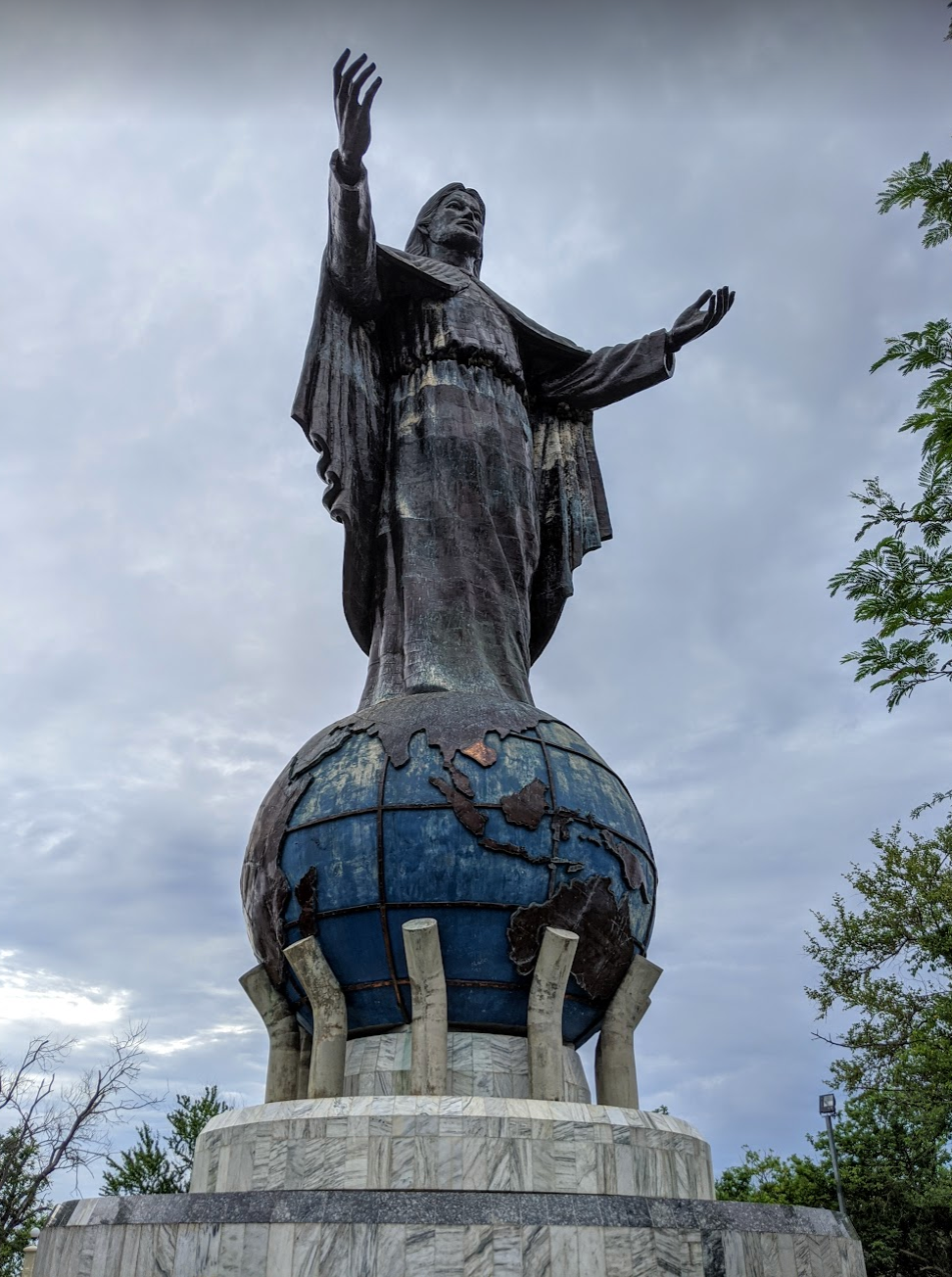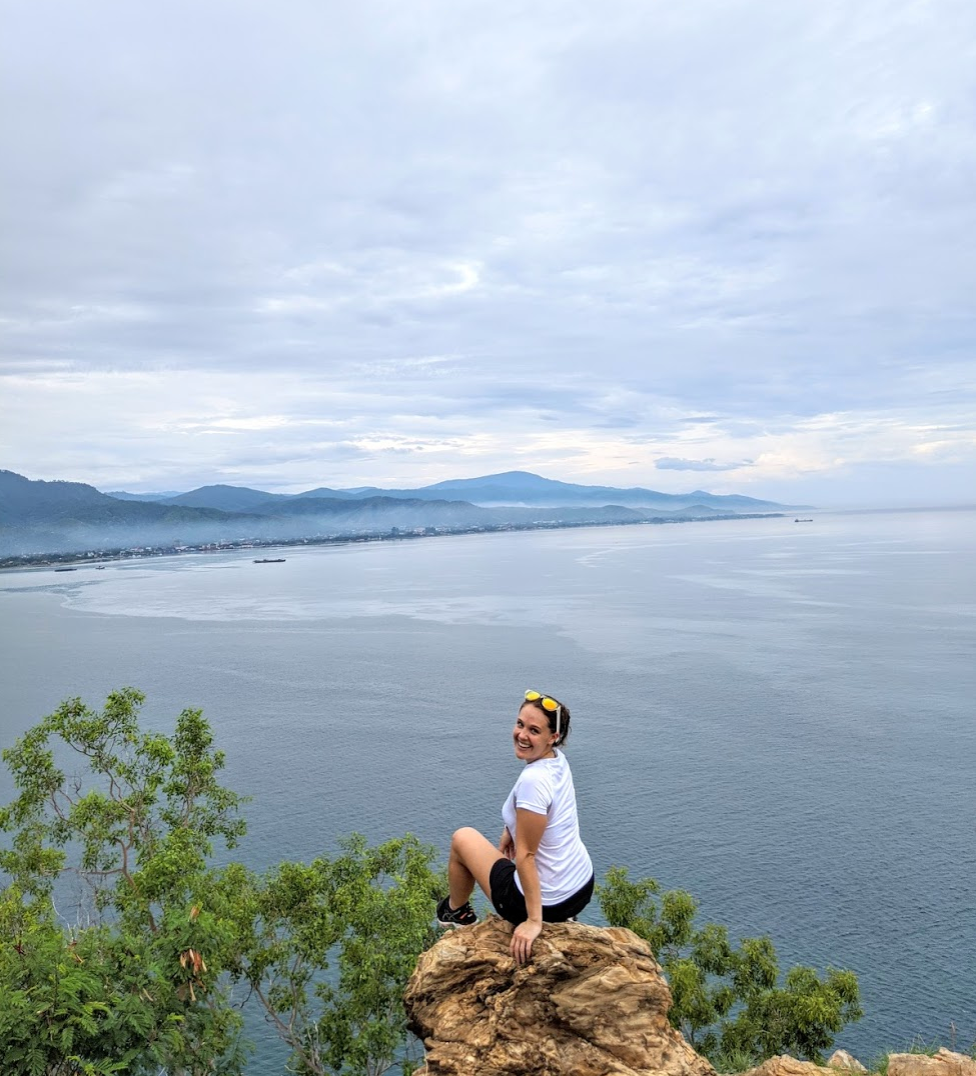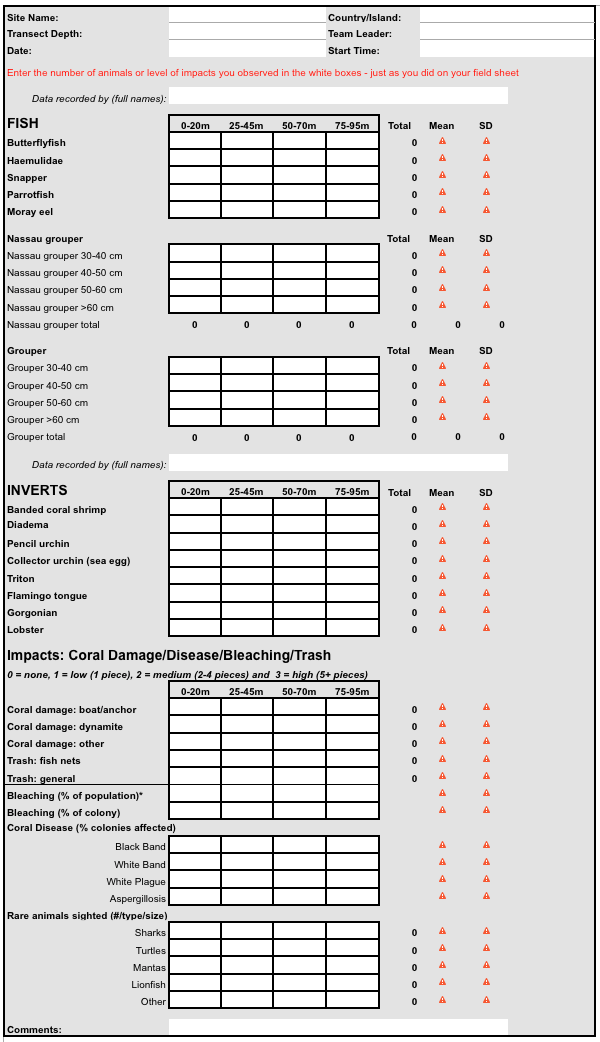Timor-Leste, a country in the middle of the coral triangle, that I had never even heard of before embarking on this incredible adventure. A country with a dark past, far from tourism, where the people are kind, and the coral reefs are still intact. Trip Plan here.

Arrival & Dili
Getting on a plane and flying somewhere completely unknown was definitely not my first time. However, for this trip I was even more “uncomfortably excited”, as I had put together quite a full itinerary: Coral Reef Surveys, First Aid Course, Rescue Diver Course, Learn the local language (Tetun), teach English & help the local community. It was all part of an expedition with Blue Ventures, a not-for-profit conservation company. They had started their new base in Timor-Leste around 4 years earlier and were still in the development stage (opposite to Belize and Madagascar, where they had established full operations 20 year ago). Check out the great movie about their conservation project in Madagascar.
Dili is the capital of Timor-Leste, but by no means does it have a big capital airport. With only one gate, the plane basically taxied towards a small house. Once I picked up my big 45l backpack from next to the plane, I made my way to the hotel. On my way there, it was interesting to notice that people spoke the local language Tetun, as well as Portuguese. Once arrived at the hotel the next few days were dedicated to getting to know the capital.

The history

Timor-Leste, also called East Timor, is an island just East of Indonesia. Most people have never heard of it, and if they have, they usually think it’s part of Indonesia. The island Timor is now divided into West Timor and East Timor. However, the entire island used to be a Portuguese colony. Whilst Timor was pushing for independence from the Portuguese, the Indonesians had other plans, and invaded Timor 9 days after they achieved their independence in 1975. What followed was Indonesian occupation until 2002, when a referendum was conducted and the majority of East Timorese voted for independence. With help from the UN, Indonesia let East Timor become its own country, whilst moving a lot of people to

West Timor (which is still part of Indonesia). Today, as mentioned, we have two parts of Timor, East and West. These two sides of the same island couldn’t be more different. In West Timor people speak Indonesian Bahasa, use Indonesian Rupiah as their currency, and are Muslim (like the rest of Indonesia). In East Timor, on the other hand, people speak Tetun & Portuguese, use USD as their currency and are Christian...
Anyway, enough with my little history lesson, but I found it fascinating that I spent a month in such a young country.
Atauro Island
After a few days in the capital Dili, we made our way to the island Atauro. The North-West of the island borders the Banda Sea, which means in the right season you can see whale migrations. We were staying on the South-East side of the island though, where all the coral reefs are found.
I had mentioned before that Atauro is part of the coral triangle, which is a triangular-shaped area spanning between Indonesia, Malaysia, Papua New Guinea, Philippines, Solomon Islands and Timor-Leste. The triangle contains at least 500 species of reef-building corals per region. In summary this means that you can find one of the highest biodiversities within these waters, especially when it comes to key coral species. Researchers also found that Atauro island is one of the most biodiverse areas when it comes to fish & invertebrate species. New species are still being discovered there on a regular basis.
Home to around 8000 people within only a few villages, Atauro island is a must visit for anyone who is into diving, free diving or snorkeling. The incredibly clear waters and sheer colour of their coral reefs really blew me away.

Daily routine
We quickly came to love our daily routine which consisted of waking up at 6am for our sunrise tank beach workout. I’m not kidding. We actually used our diving tanks as weights!

It was the best way to start the day and we all felt very energized afterwards whilst heading to breakfast at 7am. Once done, we would set up our dive gear to start on our two dives at 8am. These dives were either used for rescue diving scenarios, fish ID/benthic (corals etc.)/invertebrate point outs or reef surveys. I will talk about this more later on.
After our two dives every day, we were usually starving and headed to lunch. Food always consisted of veggies, fish or chicken and rice. The food was good, but not hugely diverse, so after a while we would get excited about the smallest things, like butter, a jar of marmalade or some cookies. We also made it a rule not to talk about outside food. Atauro is a small island with some kiosk-like shops, but definitely not the right place for foodies.

Once we had finished lunch, we had an hour of free time (i.e. studying), before the afternoon presentations/study sessions/lessons started. Every day was different, but most days included a couple of marine life presentations, a beach clean, English lessons at the local school and a Tetun lesson for us to learn the local language. These activities would go on until 6pm, and then we’d have another hour of free time (i.e. more studying) until dinner at 7pm. I’m not joking when I say that we would be in bed by 8:30pm every night. We were exhausted and the heat would finally start to cool down slightly.
For the first two weeks we were staying at Barry’s Place, a simple resort by the beach, which is powered by solar energy only. Each dorm had its own solar panel next to it! This meant that electricity was rather limited during my time there. We only had electricity during the night, 7pm-7am to be exact, which meant we had to make sure all of our cameras, phones etc. were plugged in.

The biodiversity

The coral reefs we got to see whilst staying on Atauro were out of this world. After diving all around Asia for 1.5 years I had still never seen corals like that. Very colourful, massive and everywhere. There were dive sites where we couldn’t tell where the reef started and ended, as it was just one continuous bed of corals. What struck me as well was the amount of fish. There were so many times when we signaled underwater “Look at this” or “How cool is that?”. In the photo on the left you can see a small part of a reef to show how colourful it was. There's also a small scorpion fish hiding in it. Can you spot it?
I have to mention that Timor-Leste is not really known for the big stuff, such as sharks. There is a huge variety of the smaller fish as described, which I started to appreciate so much more after knowing what species they were. I also had to learn a lot of new fish signals, to communicate the species whilst diving.
On top of the incredible reefs with all the smaller fish we saw dolphins on a regular basis. They came up to the boat and were bow riding (swimming alongside the front of the boat) for long stretches of time. I felt like I was part of a Disney movie, and got excited every time again when this happened (almost every day!).

First Aid Course
With no time to waste, we got started on the first part of my rescue diver, i.e. the first aid course. On top of working my way through the theory book (+ video) and taking regular knowledge reviews, I also had to take a final written exam. The expedition manager was overseeing my progress and made sure that each scenario was thoroughly discussed. It felt different to take a written exam on the beach, whilst in my wetsuit right after our dives, but I was not complaining. Once the theory was passed, we got started on the practical exercises. Here the fun started. The other volunteers came up with spontaneous scenarios throughout the week in which they would suddenly fall off ladders, drown, get hit by a coconut, or were simply choking on a piece of potato. It was great practice for me, but pretty exhausting at the same time. The other two volunteers were doctors, so they paid extra attention to the procedures, such as administering oxygen, bandaging a wound or doing CPR. After this baptism of fire during the second week, I felt very confident though and passed with flying colours.
Rescue Diver Course
Once the First Aid course was behind us, we were able to move on to the rescue diver theory and practice. Th theory book for that was a LOT thicker and had way more complicated scenarios. Even though practicing each and every scenario multiple times was exhausting, I could feel how with each one I became a more confident diver. From scenarios such as 'panicked diver' to 'lost & unconscious diver', each scenario had its own procedures and risks. Did you know e.g. that a lost and unconscious diver under water will have brain damage if not found and brought to the surface within 6min? In our final scenario, we had to combine all of our skills. The goal was to find a lost diver, acknowledge they were unconscious, bring them to the surface, start mouth to mouth in the water, remove their gear, bring them aboard and start CPR. All within 15(!) minutes. If you think it’s easy to find an unconscious diver underwater (i.e. no bubbles), think again. Even in great visibility it’s quite difficult.

Coral Reef Surveys
The main reason I had decided on Blue Ventures and this particular expedition was the coral reef surveys they were conducting in the area. Diving tourism in Timor-Leste is still very underdeveloped and we were here to collect data so that marine protected areas could be put in place. The aim was to put laws and regulations in place now before mass diving tourism would start. I loved that this small country, that nobody had heard of before, was taking action and wanted to avoid mass reef destruction that happens in Indonesia and Malaysia on a regular basis (not only due to tourism, but also due to dynamite fishing). Dynamite fishing had been done in Timor-Leste as well, but fortunately not in years and the reefs had started to recover. The situation in Malaysia looks quite different where three divers died from someone dropping a grenade on them in July 2019.

In order for us to survey the reefs around the coasts of Atauro island, we had to learn to identify different species first. That is a lot easier said than done! We had to identify not only fish species, but also benthic and invertebrates.
Reef Check

The basis for our surveys was reef check, a global company, that enables people to get certified, survey reefs and upload the data. Step 1: Get certified. To do this we had to pass written and practical exams in three categories: Fish, benthic and invertebrates. The written exams were quite straight forward. We used books and the app cram with flashcards to study the species and how to differentiate between them. The differentiation between some species was especially tricky! A lot of snapper, emperor and grouper species look exactly the same. We got there in the end and passed our 55 question exam. Our practical test was a bit more complicated. The first step were point outs. This meant that our marine biologist would point at fish/benthic/invertebrates underwater and then show us the species on a slate. The second step was for us to guess which ones he was pointing at, and the third step was an exam of 30 point outs, which we had to guess correctly. Doing point outs underwater is easier said than done. By the time we figured out which fish he was pointing at, the fish had disappeared into a coral or swum away. This became easier over time and by the end of the second week we had all passed and been certified. We were finally able to move on to the surveys! In order to do them we needed at least two people, one person would do fish, invertebrates and impacts, whilst the second person would do benthic and reef health in the same area. We had to roll out a measuring tape over 50m and then get counting.

Fish species, invertebrates & Impacts survey

Within this survey we had to determine the fish species first. These included groupers, snappers, butterflyfish, parrotfish, and moray eels. Blue Ventures had added more fish species into our surveys, which were important to the local ecosystem, but not necessary for reef check. This meant we also had to survey emperor, angel, wrasse, fusilier, moorish idol, and more grouper and snapper species. For the invertebrates we focussed on sea urchins, sea cucumbers, types of crabs and starfish. On the right you can see the sheet we filled in online to submit the data.
In terms of reef health we looked at what state the corals were in, what % was bleached, or had a disease (e.g. white band disease) and whether there was any damage we could discern from anchors, boats, dynamite etc.
Benthic & reef health

For the benthic survey we had to identify all hard corals, such as branching, massive, tabular, organ pipes, etc. as well as bacteria, algae, hydroids and soft corals. It got quite detailed, but was super interesting. In terms of reef health in this survey we only had to give the number of hard corals and the % of diseased corals.
Overall for me the surveys were the most fun part of the expedition, as it was such a great feeling, to have a job whilst going diving. Inputting the data into spreadsheets afterwards was a bit tedious, but the impact this data will have on the local communities and the global collection of data made it all worth it.
Hiking

On top of all the above (exams, courses and activities) we spent our weekends going hiking around Atauro island. During these hikes we would visit nearby villages and have lunch with the local staff of Blue Ventures. The hikes were long, usually between 3-4h, and to our dismay horseflies were a common occurrence in the mountains of Atauro. This meant that our legs were covered in them. Sounds fun right? Horsefly bites only really come out and start itching a day after you get them. Every Monday morning we therefore looked like we had some sort of chickenpox disease. The views during our hikes were lovely though, especially of the reefs from the mountains, and somehow made us do it again and again every weekend despite the horseflies.

Homestay
After the first two weeks on Atauro we moved from Barry’s Place to a homestay, which meant staying with a local family. We had been preparing for this day by trying to learn the local language, which was going well, but obviously not well enough to have a full on conversation. Nevertheless we had a lot of fun chasing around the family's kids, watching movies with them, and engaging in broken Tetun conversations over dinner. The food was incredible, and included a lot of veggies I had never tried or heard of before. During my time on Atauro I had gone completely vegetarian and didn’t miss meat at all. I never eat seafood anyway, but cutting out meat didn’t seem to bother me.
After three weeks of being healthy and probably in my best shape ever (due to morning workouts and very healthy food) I got a nasty stomach bug, along with almost everyone else from Blue Ventures. We were all in bed for three days trying to move as little as possible. During those days the thought of going back to civilization for a bit after the 4th week keept me going. I can tell you that, a stomach bug without shower (we only had a bucket) and only a dry toilet (no flush) is everything but fun. What doesn’t kill you makes you stronger right? After I recovered from the bug I was back in the water doing surveys in no time!
I was very sad to leave Atauro, and all the people I had gotten to know during my one month stay. It pushed me to my limits physically (especially the stomach bug) but I loved creating a routine around our days and focussing on a few topics that really interested me. I don't think I will ever see a reef in the same way, as I won't be able to stop myself from identifying any fish or coral I come across!

"How inappropriate it is to call it Planet Earth, when it is quite clearly Ocean."
Comments